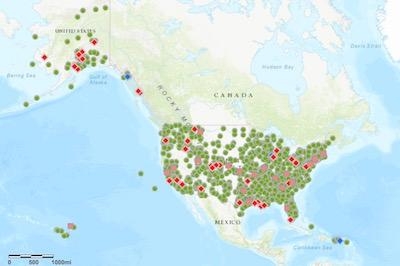Another Year With No Fatalities For Part 121 Carriers
The NTSB has released a summary of aviation accidents for Calendar Year 2015 which shows another year of no fatalities aboard aircraft operated by Part 121 carriers.

The NTSB's Summary of US Civil Aviation Accidents for Calendar Year (CY) 2015 reviews all civil aviation accidents that occurred between January 1, 2015, and December 31, 2015. This summary combines accidents involving air carriers (regulated by Title 14 Code of Federal Regulations [CFR] Part 121), commuter and on-demand carriers (regulated by 14 CFR Part 135), and general aviation (regulated by 14 CFR Part 91).
Civil aviation in the United States encompasses a broad variety of aircraft and pilots, flying for many different purposes. These operations can range from light-sport and private flights to commercial air carrier operations. The safety of civil aviation in the United States is regulated by the Federal Aviation Administration (FAA). The FAA distinguishes between commercial and general aviation operations. Commercial operations generally involve carriers that operate aircraft in revenue service, for the purpose of either passenger or cargo transport. These carriers are regulated by Parts 121 and 135.
Most air carriers regulated by Part 121 fly large, transport-category aircraft for the purpose of passenger travel. However, some carriers operating under Part 121 transport cargo only. Both passenger and all-cargo Part 121 carriers normally conduct operations in controlled airspace and at specific, uncontrolled airports that are able to provide certain weather, maintenance, and operational equipment and support.
Part 135 applies to commuter and on-demand operations, which may involve takeoffs and landings at airports that do not have the services required by Part 121. Part 135 contains different regulatory requirements than those for Part 121 operators.
Part 121 and Part 135 operations can be further classified into scheduled and non-scheduled services. Scheduled operators offer set departure locations, departure times, and arrival locations in advance of each flight's departure. Non-scheduled operators, or on-demand operators, do not operate from set locations at set times, but instead rely on their customers to determine the departure and arrival locations and times. Examples of non-scheduled operations include some Part 121 cargo operations, Part 135 air taxi operations, and certain emergency medical transport operations.
In contrast, general aviation operations encompass those not covered by Part 121 or Part 135 (or those covered by Part 129, which applies to foreign carriers operating in US airspace). Whereas Parts 121 and 135 apply to specific types of operations, general aviation encompasses a wide variety of operations, involving an even wider array of aircraft. General aviation includes all non-commercial operations, including flying for pleasure and business, along with very specific commercial operations, such as flight training and banner- or glider-towing.
According to the board, there were 1,282 total aviation accidents in 2015. Of those, 1,210 involved GA airplanes and resulted in 378 fatalities from 230 accidents. There were 43 accidents involving Part 135 Commuter and On-Demand carriers. Twenty-eight people were fatally injured in eight of those accident.
Part 121 Air Carriers were involved in 30 incidents, but none of those resulted in any fatal injury.
Some of the statistical summaries presented here use accident categories that were developed by the Commercial Aviation Safety Team (CAST)/International Civil Aviation Organization (ICAO) Common Taxonomy Team (CICTT). CICTT category development focuses on coding aircraft accident occurrences and phases of flight in a standardized and logical manner.
(Source: NTSB. Image provided)
 ANN's Daily Aero-Term (04.26.24): DETRESFA (Distress Phrase)
ANN's Daily Aero-Term (04.26.24): DETRESFA (Distress Phrase) ANN's Daily Aero-Linx (04.26.24)
ANN's Daily Aero-Linx (04.26.24) Airborne 04.22.24: Rotor X Worsens, Airport Fees 4 FNB?, USMC Drone Pilot
Airborne 04.22.24: Rotor X Worsens, Airport Fees 4 FNB?, USMC Drone Pilot Airborne 04.24.24: INTEGRAL E, Elixir USA, M700 RVSM
Airborne 04.24.24: INTEGRAL E, Elixir USA, M700 RVSM Airborne-NextGen 04.23.24: UAVOS UVH 170, magni650 Engine, World eVTOL Directory
Airborne-NextGen 04.23.24: UAVOS UVH 170, magni650 Engine, World eVTOL Directory



